
Shooting in style with Pedersoli’s Tascosa Creedmoor Rolling Block.
What Sets The Tascosa Creedmoor Rolling Block Apart:
- Curly maple stock adds another dimension to the rifle's appearance.
- Heavy octogon barrel ideal for long-range shooting.
- Set trigger makes for a featherweight break.
- Vernier ladder sight gives 300 points of adjustment.
It was one hell of a shot that September afternoon in 1874.
“Old Reliable,” Col. John Bodine, stepped to the line at Creedmoor, New York, and cracked off a 1,000-yard bull’s-eye as deftly as if it were point-blank. Adding a dash of drama, some onlookers reported blood pouring from the marksman’s hand, a mishap with a libation moments before his turn. If that’s the case, we’d all like a sip of whatever he was drinking.
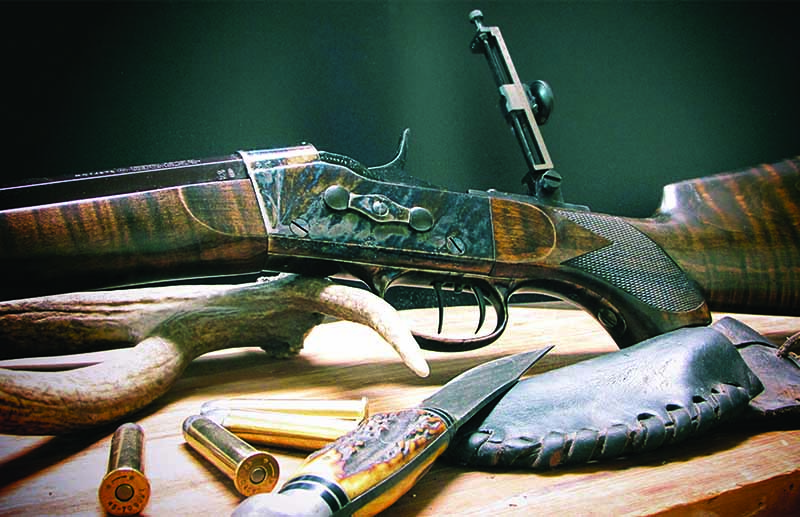
The wound, in all likelihood, is a bit of embellishment. Undeniable about the shot, it delivered the Americans a win against the world-renown Irish team. Also indisputable was the instrument at the crack shot’s shoulder—a Remington Rolling Block Rifle.
While time and technology shadow the long arm in modern-day shooters’ minds, the absurdly simple, accurate and somewhat underrated rifle remains among the most consequential single-shots of all time. It was, after all, the most used single-shot military rifle of all time. And thanks to the likes of traditional firearms manufacturers, such as Davide Pedersoli, the hair splitter soldiers on today—one might argue, even better than before.
Those might seem like big words, until you get a gander at Pedersoli’s latest rendition of the rifle. An attempt at balancing form and function, the Tascosa Creedmoor Rolling Block is something special. And, after some time with a .45-70 Government model of the brand-new throwback, it’s difficult to deny the rifle looks as sharp as it shoots.
Stocking Up
For those who don’t reek of black powder smoke, it’s worth noting that Pedersoli has become among the foremost makers of replica arms. If it pitched lead from around the American Revolution through the Old West, it likely rolls out of the manufacturer’s Northern Italy factory.
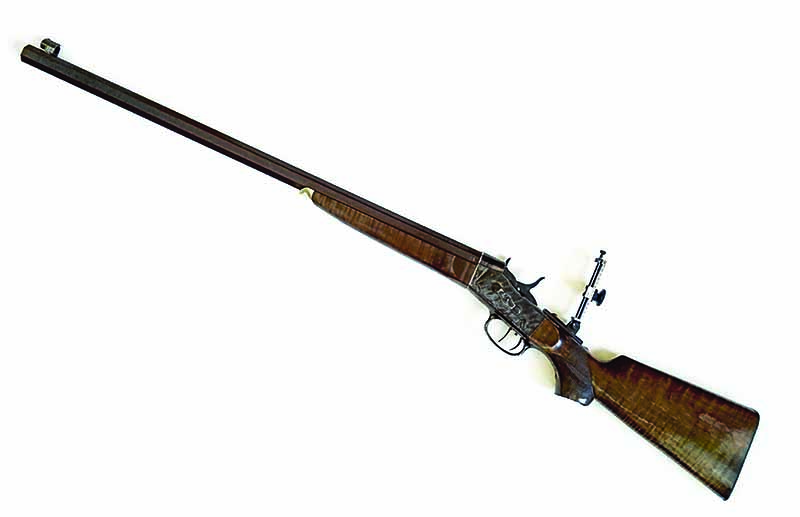
The old Remington Rolling Block, perhaps one of the strongest breech-loading designs ever conceived, is one of their staples. And while Pedersoli has faithfully recreated both practical and target renditions of the rifle, nothing quite like the Tascosa had previously come off its line.
Boasting the same stock design as the Creedmoor version of the rifle—of Bodine fame—the gunmaker has upgraded the gun with a somewhat unorthodox stock material: maple. I can hear the noses wrinkling because who wants that blond stuff on a gun that, even brand new, is supposed to have a gritty patina about it. Prepare to be surprised.
More Classic Guns:
- Going the Distance with the Sharps Rifle
- Classic Guns: The Sweet Ruger No. 1 Rifle
- Restored To Life: Winchester 1886
- 1860 Henry Rifle Past And Present
Pedersoli opted not for bird’s eye or one of those other light-hued cuts for the rolling block, but a deep, rich heartwood with loads of character. Tiger maple—a certain pattern of curly maple—is often found in musical instruments, but it’s not all Les Paul. American long rifles were often stocked in cuts of curly maple, and the wood has more than proven itself as a stocking material. On the rolling block, the dark, reddish heartwood cut does add a new dimension to the classic arm. And the target model is just the start.
Tascosa (named after a ghost town in Texas) isn’t just a new style of rolling block, but an entire series. Planned for release sometime this summer, the company’s 1874 Sharps, 1885 High Wall, 1886 Lever Action and Trapdoor Rifle will all be available in the Cadillac stock option. That bodes well not just for those who yearn for a wall hanger.

At least for target models, the heavier and more rigid wood has the potential of enhancing the accuracy potential of the guns. Maybe that won’t win the hearts of backwoods hunters, but given the already tight throwback precision rifles the company produces, it’s certain to enamor those who shoot a country mile.
Shoot’n Parts
No surprise on a rifle dubbed “Creedmoor,” it aims to pitch lead to its limits. Pedersoli does everything in its power to make it happen.
This is no more evident than in the rifle’s massive target barrel. At 30 inches in length and 1 inch from top flat to bottom, the octagon fire tube resembles a small piece of artillery. But the massive amount of plum-finished stainless steel plays an important role in keeping the rifle on target. Much like today’s bull barrels, the rolling block’s super-sized version shrugs off heat and ensures consistent harmonics. No whip here.
However, it’s the interior of the tube where the real magic happens. Pedersoli’s boring and rifling process is second to none, involving polishing the bore to a mirror finish before cutting the rifling. In turn, the .45-70’s six grooves and lands offer a near-perfect surface to send a bullet on its way, with less friction and deformation in the deal.
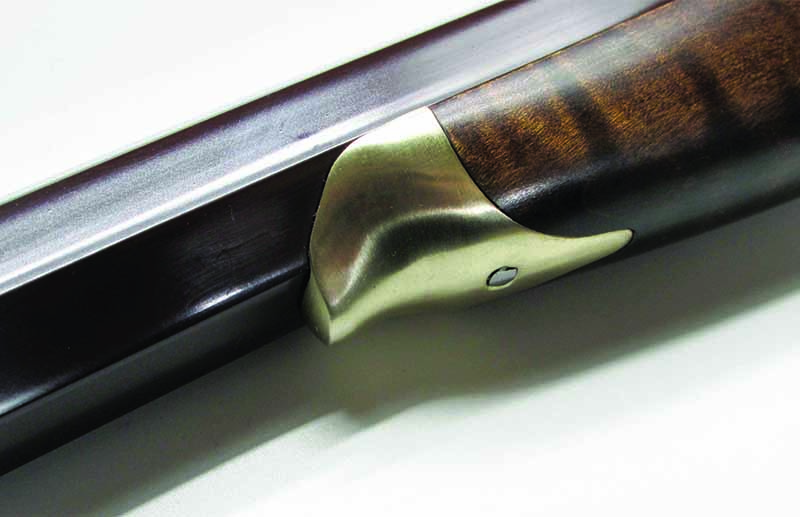
As expected, the sheer amount of barrel makes for a weighty rifle. Given few will ever shoot the rolling block sans sticks, tripods or bench, this doesn’t matter much. Besides, Pedersoli has perfectly balanced the tube in the attractive stock, putting its pivot point nearly smack-dab at the nose of the slender forend. They’ve also included a brass endpiece on the fore with a wide groove, so you don’t scuff up the maple. Thoughtful.
All this is well and good, but the star of the show comes under the rifle’s color-case hardened receiver. Boy, unless you’ve shot F-Class, it’s unlikely you squeezed anything quite as light and crisp as Pedersoli’s set trigger. It’s the classic two-trigger design, the rear setting the sear and the front dropping the hammer. The difference between standard and set weights are night and day—7 pounds to roughly 2 ounces (sorry, my Wheeler scale didn’t measure quite that low). No arguments a real boost to accuracy, once you discipline that itchy trigger finger.
As to the rest of the rifle, the rolling block is a rock-solid system cooked up just after the American Civil War—the evolution of the split block. Easily, it’s as strong, if not stronger, than the popular falling-block designs. But it has the distinct advantage over the like of the Sharps or even Ruger’s No. 1—no lever action. Not only does this potentially eliminate mechanical error—the rolling block only has two moving parts in its action—but also makes shooting prone simpler. No need to contort to load the next round with all controls north of the receiver.
Not to thumb my nose at falling block fans, but I find the rolling block much more convenient. If, for no other reason, it’s much quicker on the reload, which is easier to accomplish with the rifle still on the shoulder.
Out of Sight
I’d be remiss if I didn’t take a moment to talk about the rolling block’s sight system. The frontier version of today’s high-powered rifle scopes, the Vernier rear peep sight and tunnel front sight, take some study to grasp in their entirety. But once a shooter catches the drift of how to dial it in, the system drops rounds in like no other traditional system.
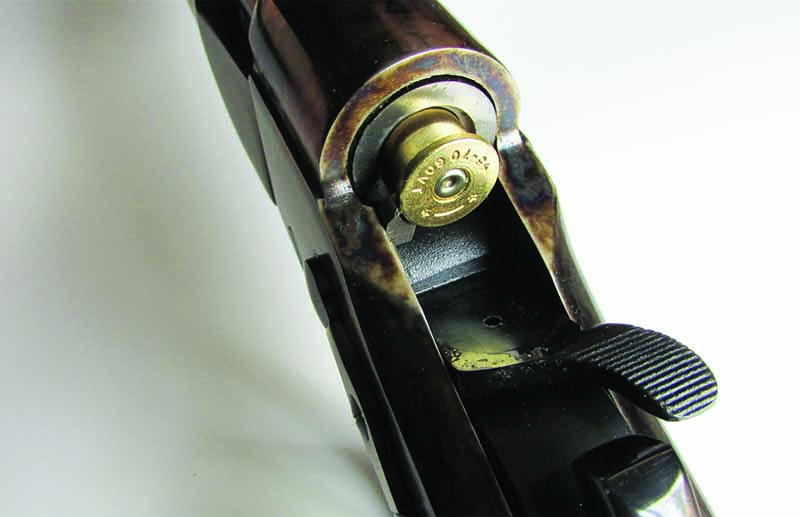
The Tascosa Creedmoor comes with plenty of sight, too. The rifle ships with a 3-inch version of the tang sight, which offers 300 points of elevation adjustment. In the case of the rifle I tested, with a 34-inch sight radius, that equates to 300 MOA at 100 yards! Windage is equally as fine, .025 inch or 2.5 MOA, but I found a rare bone to pick here. In all but the brightest light, it’s nigh impossible to read windage. Deal-breaker? No. But plan to have your readers and a flashlight on hand if you’re shooting in the shade.
At the Range
Staying true to the heritage of the gun in-hand, I opted to run Black Hill’s 405-grain Authentic Cowboy Action ammo. A solid-lead load, built to emulate yesteryear’s lower-velocity ammunition. It was an apt option for the rolling block … and it performed marvelously.
Using a crosshair insert in the front sight, it took two shots and seven points of elevation adjustment to get on paper at 100 yards. From there, it was off to the races. The first three rounds down range produced my best group of the day, a hair above ½ inch—the third shot clipping the second. While there were fliers—no fault of the rifle—I’m pleased to report they were polite enough to easily smash the vitals of a lead buffalo at 500 yards.
I shot off sandbags the entire afternoon and found the rifle extremely comfortable and responsive. The fore’s flat bottom sits steadily on a malleable surface, and the tall(ish) comb made lining up the peep intuitive. The steep pistol grip tended toward large, but not so oversized to prove awkward or uncomfortable.
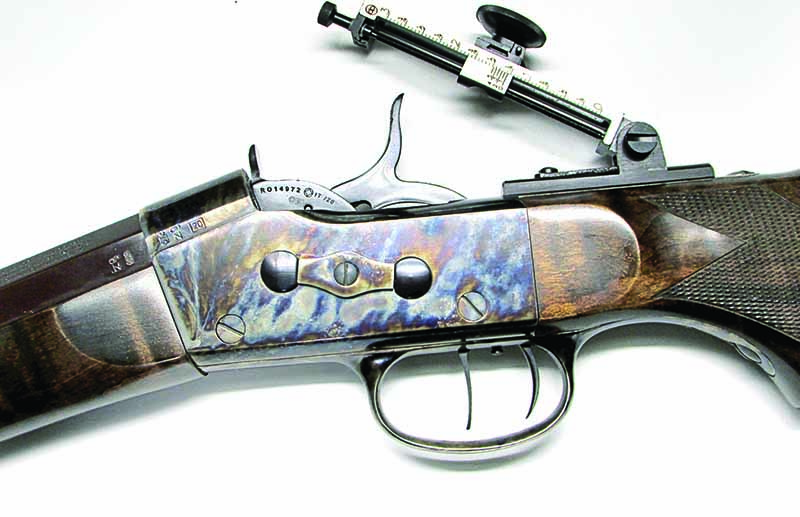
Though the true star of the show was the rifle’s trigger. While requiring discipline when set, the interface is so responsive that you can’t help but hit what you’re aiming at. As to its baseline reliability: It’s a rolling block. It’d be banner news if it didn’t hold tight, drop its hammer and extract brass.
Parting Shot
I have a friend who says, “Nostalgia is a terrible liar.” For the most part, he’s right. We should rejoice the days of polio and mule-drawn plows are behind us. But for every truism, there’s an exception—the Tascosa Creedmoor Rolling Block is one.
Proving bygone technology still performs in the right hands, the time-tested breech loader is a positive delight. Not only does it tick off the right boxes when it comes to precision shooting, but it also is about the prettiest dang iron I’ve set my hands on in a spell.
Decidedly, the Tascosa Rolling Block isn’t for everyone, particularly with a $2,500 MSRP. But the right shooter—maybe a dedicated single-action long-range match marksman—will find it worth every penny.
One thing is for certain: It lives up to the exacting standards Bodine set for the rifle all those years ago.
Tascosa Creedmoor Rolling Block Specs
Caliber: .45-70 Government
Overall Length: 46 inches
Weight: 12 pounds
Barrel Length: 30 inches
Rear Sight: Creedmoor Adjustable
Front Sight: Tunnel
Grooves: 6
Twist: 1:18
MSRP: $2,500
For more information on the Tascosa Rolling Block Rifle, please visit davide-pedersoli.com.
Editor's Note: This article originally appeared in the May 2021 issue of Gun Digest the Magazine.

Next Step: Get your FREE Printable Target Pack
Enhance your shooting precision with our 62 MOA Targets, perfect for rifles and handguns. Crafted in collaboration with Storm Tactical for accuracy and versatility.
Subscribe to the Gun Digest email newsletter and get your downloadable target pack sent straight to your inbox. Stay updated with the latest firearms info in the industry.

![Best Concealed Carry Guns In 2025 [Field Tested] Wilson Combat EDC X9S 1](https://gundigest.com/wp-content/uploads/Wilson-Combat-EDC-X9S-1-324x160.jpg)


![Best 9mm Carbine: Affordable PCCs [Tested] Ruger Carbine Shooting](https://gundigest.com/wp-content/uploads/Ruger-Carbine-Shooting-100x70.jpg)
![Best AR-15: Top Options Available Today [Field Tested] Harrington and Richardson PSA XM177E2 feature](https://gundigest.com/wp-content/uploads/Harrington-and-Richardson-PSA-XM177E2-feature-100x70.jpg)
